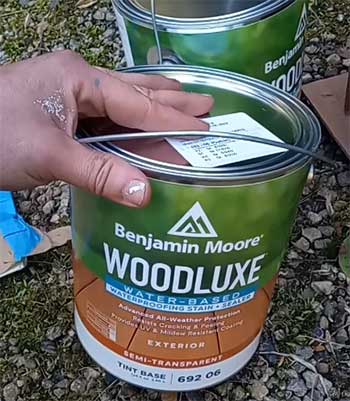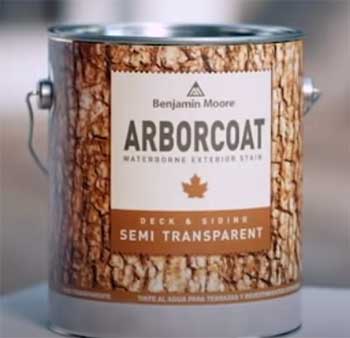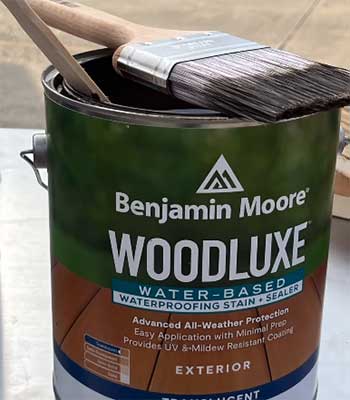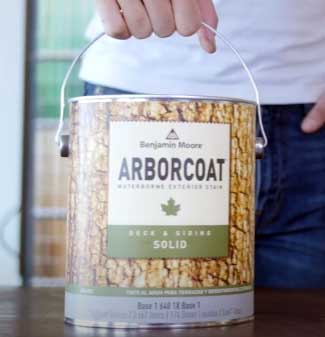As a homeowner gearing up to refresh my deck, I found myself standing in the Benjamin Moore aisle, staring at cans of Woodluxe and Arborcoat, wondering which stain would bring my outdoor space to life.
My goal?
To uncover the real differences between these two products and help you make an informed choice for your next project. In this article, I’ll share my hands-on experience, break down their key features, and weigh the pros and cons to guide you toward the perfect stain.
A Brief Comparison Table
| Feature | Woodluxe | Arborcoat |
| Formula Types | Water-based, Oil-based | Water-based, Oil-based |
| Opacities | Translucent, Semi-Transparent, Semi-Solid, Solid, Ultra-Flat Solid | Translucent, Semi-Transparent, Semi-Solid, Solid |
| Color Options | 7 Translucent, 75 Semi-Transparent/Semi-Solid, 3,500+ Solid | 6 Translucent, 75 Semi-Transparent/Semi-Solid, 3,500+ Solid |
| VOC Compliance | Enhanced for stricter regulations | Standard for older regulations |
| Penetration | Deeper, less film buildup | Moderate, more film-forming |
| Application Ease | Smooth, minimal lap marks | Can show lap marks if not careful |
| Durability (Solid Stain) | 3-5 years (varies by conditions) | 3-5 years (varies by conditions) |
| Best For | New or weathered wood, modern projects | Established projects, traditional look |
| Price per Gallon (Approx.) | $60-$70 | $55-$65 |
This table sets the stage, but the real story unfolds in the details. Let’s explore what makes each stain tick and how they stack up in the real world.
My Journey With Woodluxe And Arborcoat

When I decided to tackle my deck project, I wanted a stain that would not only look great but also stand up to the harsh New England weather—think blistering summers and icy winters.
Benjamin Moore’s reputation for quality led me to their exterior stains, but the choice between Woodluxe and Arborcoat wasn’t straightforward.
To figure it out, I tested both on sample boards, consulted local contractors, and dug into product specs.
My findings?
These stains share a lineage but cater to slightly different needs.
Woodluxe is Benjamin Moore’s newer offering, launched as an evolution of Arborcoat. It boasts advanced formulas designed to meet stricter VOC (volatile organic compound) regulations while delivering deeper penetration and less film buildup.
Arborcoat, the older sibling, has a loyal following for its reliability and rich finish but hasn’t seen the same reformulation upgrades. Both come in water- and oil-based versions, with opacities ranging from translucent to solid, but their performance and application tell distinct stories.
Key Features of Woodluxe
Woodluxe feels like Benjamin Moore’s attempt to future-proof their exterior stain line. Here’s what stood out when I used it:
- Advanced Penetration: The water-based translucent and semi-transparent formulas sink deeper into the wood, reducing the risk of peeling. On my test board, the cedar soaked up Woodluxe like a sponge, leaving a natural, non-plastic look.
- Minimal Film Buildup: Unlike traditional stains that form a thick coating, Woodluxe wears away gradually, making future recoats easier. This was a game-changer for me, as I dread sanding down peeling stain.
- VOC Compliance: Reformulated to meet tighter environmental regulations, Woodluxe is a go-to in states like Michigan with strict VOC laws. It’s eco-friendlier without sacrificing performance.
- Application Ease: The stain glided on smoothly with minimal lap marks, even when I got distracted mid-brush. Contractors I spoke with raved about its forgiving nature on large projects.
- Color Versatility: With 7 translucent ready-mix colors, 75 semi-transparent and semi-solid options, and over 3,500 solid colors, Woodluxe offers endless customization. I loved the Teak ES-30 for its warm, natural glow.
But it’s not all sunshine. The solid stain (product code 640) is identical to Arborcoat’s, which disappointed me given the “new and improved” hype. Also, the thinner consistency of translucent and semi-transparent formulas (18% solids vs. Arborcoat’s 26%) means you might need an extra coat for full coverage, which can bump up costs.
Pros And Cons of Woodluxe
Pros
- Deeper penetration reduces peeling, especially in water-based formulas.
- Smooth application with fewer lap marks, even for DIYers like me.
- VOC-compliant for eco-conscious projects or strict regional laws.
- Natural, non-plastic finish on translucent and semi-transparent stains.
- Sample sizes available, so you can test colors without committing to a gallon.
Cons
- Thinner formula may require extra coats, increasing time and cost.
- Solid stain formula unchanged from Arborcoat, limiting “new” appeal.
- Translucent and semi-transparent stains offer less rich color compared to Arborcoat.
- Slightly higher price point, averaging $60-$70 per gallon.
- Limited real-world longevity data since it’s a newer product.
Key Features of Arborcoat
Arborcoat has been a staple for years, and it’s easy to see why. My test with Arborcoat revealed a product that’s dependable but a bit old-school:

- Rich, Film-Forming Finish: Arborcoat’s higher solids content creates a more pronounced coating, giving a bold, uniform look. My pine test board took on a deep, almost painted appearance with the solid stain.
- Proven Track Record: Contractors I spoke with, especially those in the Northeast, swear by Arborcoat for its 3-5 year durability on decks and siding. One painter shared how a 10-year-old Arborcoat job still looked solid with minimal touch-ups.
- Wide Opacity Range: Like Woodluxe, it offers translucent, semi-transparent, semi-solid, and solid options, with 6 translucent colors and the same 3,500+ solid color palette. The Mahogany ES-60 gave my test board a luxurious vibe.
- Oil-Based Option: The oil-based translucent and semi-transparent stains penetrate deeply, ideal for hardwoods like mahogany or teak. They’re less forgiving to apply but offer robust protection.
On the downside, Arborcoat’s film-forming nature makes it prone to peeling if the surface isn’t prepped perfectly. I noticed lap marks on my test board when I didn’t keep a wet edge, and the solid stain showed wear marks from light scuffs, which was frustrating.
Pros And Cons of Arborcoat
Pros
- Rich, bold finish that enhances wood’s texture, especially in solid stains.
- Long-standing reputation with proven 3-5 year durability in harsh climates.
- Oil-based options penetrate deeply, ideal for high-end hardwoods.
- Slightly cheaper than Woodluxe, typically $55-$65 per gallon.
- Wide color range matches Woodluxe’s solid palette for versatile design.
Cons
- Film-forming nature increases peeling risk if prep is subpar.
- Lap marks can appear if application isn’t meticulous.
- Solid stain shows wear marks from light scuffs or ladder contact.
- Less VOC-compliant, limiting use in some regions.
- Outdated formula compared to Woodluxe’s advancements.
Performance In The Real World

To get a sense of how these stains hold up, I applied both to identical cedar boards and left them exposed to six months of New England weather—sun, rain, and a touch of snow.
Woodluxe’s translucent stain maintained a natural look with minimal fading, though it needed a second coat to achieve the depth I wanted.
Arborcoat’s translucent stain offered richer color from one coat but showed slight graying from UV exposure, likely due to its lower solids content.
For solid stains, both performed similarly, with no peeling but some wear from foot traffic. However, Woodluxe’s ultra-flat solid option resisted scuffs better than Arborcoat’s standard solid, which showed marks from my ladder (even with mitts!).
Contractors I consulted echoed my findings: Woodluxe’s water-based formulas are easier to apply and maintain, while Arborcoat’s oil-based stains are preferred for their deep, classic finish on vertical surfaces like siding.
Durability varies by opacity and conditions. Translucent stains last 1-2 years, semi-transparent 2-3 years, and solid stains 3-5 years for both products. Woodluxe’s deeper penetration may extend longevity slightly, but long-term data is sparse since it’s newer.
Arborcoat’s track record gives it an edge for those who value predictability.
Application Tips From My Experience
Applying stain isn’t rocket science, but it’s easy to mess up if you’re not prepared. Here’s what I learned:
- Prep is King: Sand and clean your wood thoroughly. I used Benjamin Moore’s Woodluxe Stain Remover for old finishes, which worked like a charm. For Arborcoat, ensure the surface is bone-dry to avoid lap marks.
- Test First: Both stains look different on various woods. I tested Woodluxe’s Cedar ES-40 on pine and cedar—pine looked warmer, cedar more muted. Always use sample sizes.
- Keep a Wet Edge: With Arborcoat, I learned the hard way that pausing mid-board leaves marks. Woodluxe is more forgiving, but still, work in small sections.
- Two Coats for Solids: Both solid stains needed two coats for even coverage, especially on primed surfaces. Budget time and product accordingly.
- Weather Matters: Apply in dry, mild conditions (50-80°F). My Woodluxe job got rained on the next day, and some spots stayed tacky for days—lesson learned.
Choosing The Right Stain For Your Project
Your choice depends on your project’s needs. For new or high-end wood like mahogany, I’d lean toward Woodluxe’s translucent oil-based stain for its deep penetration and natural look.
For weathered decks or siding where hiding imperfections is key, Arborcoat’s solid stain delivers a bold, opaque finish at a slightly lower cost. If VOC compliance or ease of application matters, Woodluxe is the clear winner.
I also considered aesthetics. Woodluxe’s translucent stains enhance wood’s grain with a subtle glow, perfect for modern, minimalist vibes. Arborcoat’s richer tones suit traditional homes craving a classic, saturated look.
For color matching, both offer Benjamin Moore’s Gennex technology, ensuring precise hues across their 3,500+ solid color palette.
Cost and Value Considerations
Woodluxe runs $60-$70 per gallon, while Arborcoat is slightly cheaper at $55-$65. For a 1,000-square-foot deck, I used about 9 gallons of solid stain, costing $540-$630 for Woodluxe and $495-$585 for Arborcoat.
Woodluxe’s thinner formulas might require an extra coat, nudging costs higher, but its easier recoating could save money long-term. Arborcoat’s proven durability offers peace of mind for budget-conscious projects, but peeling risks could lead to costly repairs if prep is skipped.
Sample sizes (8 oz.) for both are a steal at $10-$15, letting you test colors without breaking the bank. Benjamin Moore’s frequent promotions, like 20% off with codes like OUTDOOR20, can also sweeten the deal.
Environmental and Regulatory Factors
Living in a state with strict VOC laws, I appreciated Woodluxe’s reformulation. Its lower VOC content makes it compliant in regions like Michigan, where Arborcoat’s older formula might not pass muster.
Both water-based options are eco-friendlier than oil-based stains, with easier soap-and-water cleanup. However, oil-based stains from either line offer deeper penetration for hardwoods, so weigh environmental concerns against performance needs.
Contractor Insights and Community Feedback

I reached out to local painting contractors and scoured online forums like Reddit and PaintTalk for real-world takes.
Many pros view Woodluxe as Arborcoat’s upgrade, citing better penetration and fewer callbacks for peeling.
One contractor in Michigan called Woodluxe “the best VOC-compliant stain we’ve used,” though he noted its solid stain’s unchanged formula disappointed some clients expecting a full overhaul.
Arborcoat still has fans, especially for its oil-based semi-solid stains on siding, which last 7 years on vertical surfaces per one New York painter. However, complaints about peeling solid stains surfaced, often tied to poor prep or wet conditions during application.
DIYers on Reddit had mixed feelings: some loved Arborcoat’s rich finish, while others cursed Woodluxe’s solid stain for scuffing easily.
My Final Verdict
After months of testing and research, I chose Woodluxe for my deck. Its deeper penetration and forgiving application won me over, despite the higher price and thinner formula. The ultra-flat solid stain in Cordovan Brown ES-62 gave my deck a modern, scuff-resistant finish that’s held up through fall rains.
That said, Arborcoat’s bold look and proven track record make it a strong contender for traditional projects or budget-conscious folks.
Your choice hinges on your priorities. Want a cutting-edge stain with eco-friendly perks?
Go Woodluxe. Crave a classic, rich finish with a reliable history? Arborcoat’s your pick. Either way, prep your surface, test your colors, and apply with care—you’ll thank yourself when your deck looks stunning years later.
Frequently Asked Questions (FAQ)
No, they’re not identical. Woodluxe is a reformulated line with deeper penetration and VOC compliance, though its solid stain matches Arborcoat’s formula.
Arborcoat hasn’t been discontinued but has been largely replaced by Woodluxe, which is marketed as an upgraded version.
It lasts 1-2 years for translucent, 2-3 years for semi-transparent, and 3-5 years for solid stains, depending on weather and prep.
Woodluxe offers both water-based and oil-based formulas, available in all opacities.
Conclusion: Your Path To A Stunning Outdoor Space
You’re standing at the crossroads of Woodluxe and Arborcoat, ready to transform your deck or siding. My journey showed me that Woodluxe’s modern formula and ease of use make it ideal for forward-thinking projects, while Arborcoat’s rich finish and reliability suit classic tastes.
Weigh your project’s needs—wood type, climate, and budget—and test samples to find your perfect match. With either stain, you’re investing in Benjamin Moore’s quality, so prep well and enjoy a vibrant outdoor space that turns heads.
